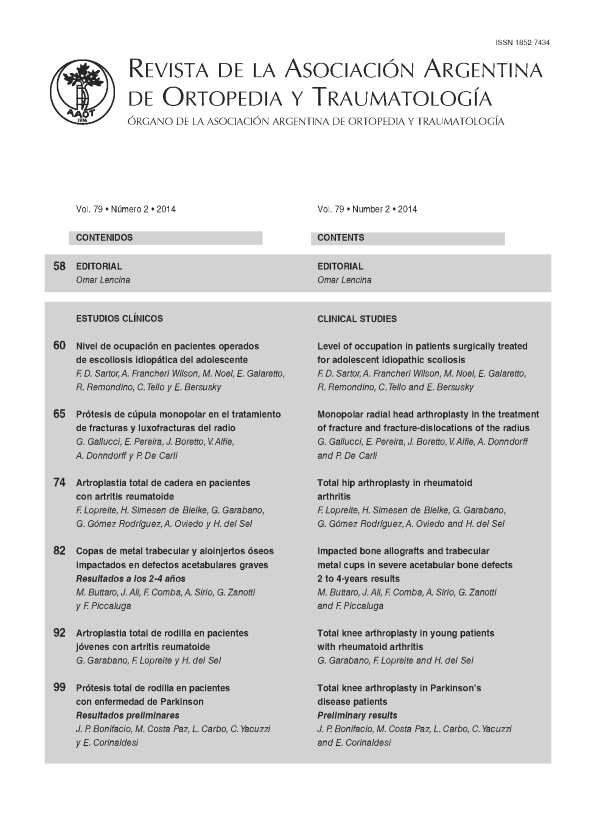Development of a low-cost simulator to acquire basic arthroscopic skills
Main Article Content
Abstract
Downloads
Metrics
Article Details

This work is licensed under a Creative Commons Attribution-NonCommercial-ShareAlike 4.0 International License.
Manuscript acceptance by the Journal implies the simultaneous non-submission to any other journal or publishing house. The RAAOT is under the Licencia Creative Commnos Atribución-NoComercial-Compartir Obras Derivadas Igual 4.0 Internacional (CC-BY-NC.SA 4.0) (http://creativecommons.org/licences/by-nc-sa/4.0/deed.es). Articles can be shared, copied, distributed, modified, altered, transformed into a derivative work, executed and publicly communicated, provided a) the authors and the original publication (Journal, Publisher and URL) are mentioned, b) they are not used for commercial purposes, c) the same terms of the license are maintained.
In the event that the manuscript is approved for its next publication, the authors retain the copyright and will assign to the journal the rights of publication, edition, reproduction, distribution, exhibition and communication at a national and international level in the different databases. data, repositories and portals.
It is hereby stated that the mentioned manuscript has not been published and that it is not being printed in any other national or foreign journal.
The authors hereby accept the necessary modifications, suggested by the reviewers, in order to adapt the manuscript to the style and publication rules of this Journal.
References
2. Hodgins JL, Veillette C. Arthroscopic proficiency: methods in evaluating competency. BMC Med Educ 2013;13:61.
3. Camacho FJ, Herrera DP, Peralta MC, Rodríguez GP, Cortés M, Alonso GO, et al. Estandarización de un nuevo método de
entrenamiento para la adquisición de habilidades en cirugía endoscópica mediante el empleo de simuladores. Rev Méd Unisanitas
2010;13(1):40-5.
4. Camacho FJ, Ramírez JF, Herrera DP, Cortés DM. Curso Básico de Entrenamiento en Habilidades para Cirugía Endoscópica:
grado de satisfacción de los profesionales en formación. Rev Col Or Tra 2009;23:16-20.
5. Rodríguez-García J, Turienzo-Santos E. Formación quirúrgica con simuladores en centros de entrenamiento. Cir Esp
2006;79(6):342-8.
6. Jones DB. Video trainers, simulation and virtual reality. Asian J Surg 2007;30(1):6-12.
7. Kohn L. To Err is Human. Building a Safer Health System. Washington, D.C.: National Academies Press; 1999.
8. Bridges M, Diamond DL. The financial impact of teaching surgical residents in the operating room. Am J Surg 1999;177(1):28-
32.
9. Karam MD, Pedowitz RA, Natividad H, Murray J, Marsh JL. Current and future use of surgical skills training laboratories in
orthopaedic resident education: a national survey. J Bone Joint Surg Am 2013;95(1):e4.
10. Dubrowski A, Backstein D. The contributions of kinesiology to surgical education. J Bone Joint Surg Am 2004;86(12):2778-81.
11. Peyton JW, Allery L. The learning cycle. En: Peyton JW (ed.) Teaching & Learning in Medical Practice. Guildford: Manticore
Europe Limited; 1998.
12. Lake FR, Hamdorf JM. Teaching on the run tips 5: teaching a skill. Med J Aust 2004;181(6):327-8.
13. Kitson J, Blake SM. A model for developing psychomotor skills in arthroscopic knot tying. Ann R Coll Surg Engl 2006;88:501-
5.
14. Andersen C, Winding TN, Vesterby MS. Development of simulated arthroscopic skills. Acta Orthop 2011;82(1):90-5.
15. Schout BM, Hendrikx AJ, Scheele F, Bemelmans BL, Scherpbier AJ. Validation and implementation of surgical simulators: a
critical review of present, past, and future. Surg Endosc 2010;24(3):536-46.
16. Butler A, Olson T, Koehler R, Nicandri G. Do the skills acquired by novice surgeons using anatomic dry model transfer
effectively to the task of diagnostic knee arthroscopy performed on cadaveric specimens? J Bone Joint Surg Am 2013;15(1):1-8.
17. Cerrolaza M, Miquilarena R, Urbina B, Prado A, Navas H. Realidad virtual para entrenamiento en cirugía laparoscópica.
Rev Venez Cir 2006;59(2):2-4.
18. Pedowitz RA, Esch J, Snyder S. Evaluation of a virtual reality simulator for arthroscopy skills development. Arthroscopy
2002;18(6):e29.
19. Hasson HM, Kumari N V, Eekhout J. Training simulator for developing laparoscopic skills. JSLS 2001;5(3):255-65.
20. Howells NR, Brinsden MD, Gill RS, Carr AJ, Rees JL. Motion analysis: a validated method for showing skill levels in
arthroscopy. Arthroscopy 2008;24(3):335-42.
21. Martín S, María M. Formación y adiestramiento en traumatología y cirugía ortopédica. Rev Esp Cir Osteoart 2007;42(232):139-
80.

